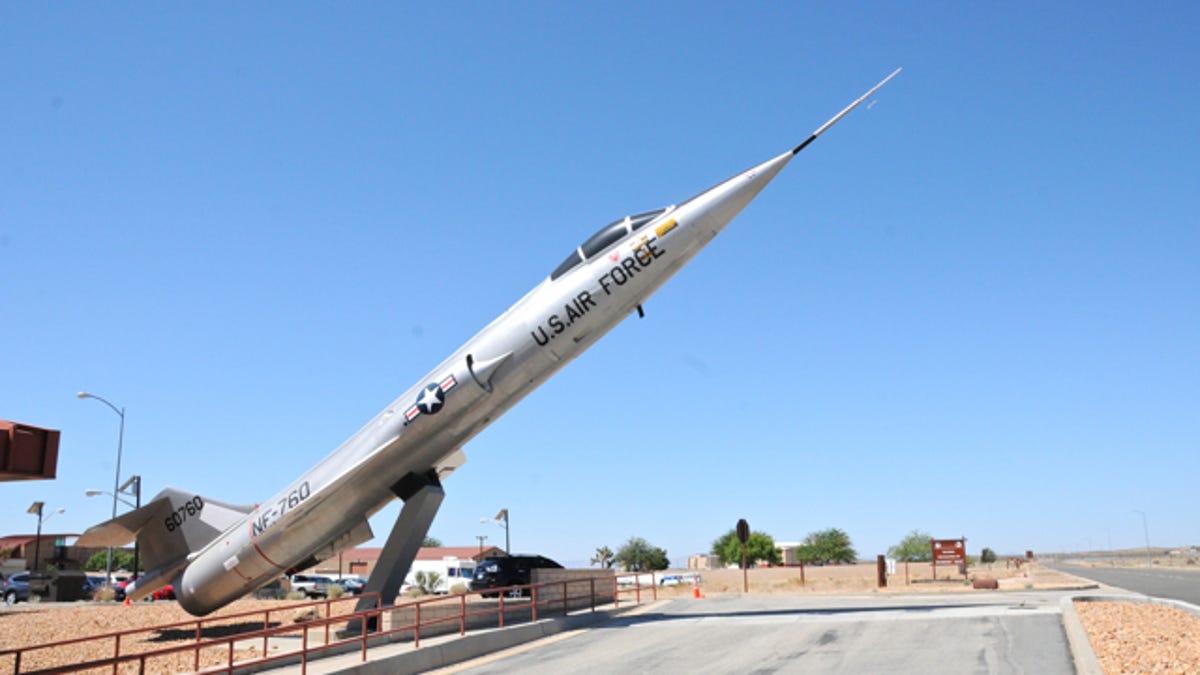Getting schooled with the Air Force's elite test pilots
Every year, 40 of Air Force's best come to the Mojave for 12 grueling months at the service's Test Pilot School. CNET Road Trip 2012 stopped in at Edwards AFB to see how it works.

EDWARDS AIR FORCE BASE, Calif.--He might be the most famous airman in the history of the U.S. Air Force, and he's a graduate of the Test Pilot School.
In 1947, Capt. Chuck Yeager became the first person to break the sound barrier, hitting Mach 1.0 in a Bell X-1 rocket plane 42,000 feet above this Mojave Desert outpost. And today, to commemorate the import of the event that ushered in the supersonic era, the aircraft hangs from the ceiling in the entryway of the Smithsonian's Air & Space Museum in Washington, D.C.
Yeager is also probably the most famous graduate of the U.S. Air Force's Test Pilot School (PDF), which has its home at Edwards and puts between 40 and 48 of America's (and some of its allies') best military pilots through a rigorous, year-long program, training this "cream of the crop" to be able to conduct a myriad of tests on experimental Air Force planes in order to "identify problems before they become chronic," said Paul Meyer, the colonel in charge of the school's instruction program.
I've come to Edwards -- and to the Test Pilot School -- as part of Road Trip 2012, and as a fan of the great film about the beginnings of the space race, "The Right Stuff," I'm very familiar with some of the base's most famous exploits. As it happens, my visit coincided with the first day of a new class of students, 24 accomplished pilots in for perhaps the toughest year of their life.
According to Meyer, the students, who are chosen from among many more applicants than there are spaces in the program, spend their year learning the skills required to put Air Force planes through their paces so that when less experienced pilots get their hands on them in combat, or other situations, there's no question that the aircraft are up to the task at hand.
The idea here is that the program -- which gives its graduates accredited master's degrees in applied flight test engineering -- is the place "where the world comes to educate future test leaders," Meyer explained. Ultimately, what that means is that these students spend a year in a variety of classes, and flying a wide range of planes, learning to identify problems with new aircraft before they are deployed and pilots who don't know how to handle those issues find themselves in dire circumstances.
The Air Force's Test Pilot School got its start in 1944 and moved to Edwards in 1951. Over the years, it has graduated 2,760 students -- 62 of whom have become astronauts. Yeager would likely have been a member of the Mercury program, NASA's first set of astronauts, but he didn't have a college degree. The Test Pilot School requires a degree, and Yeager may well be the only graduate in the institution's history without one. This fact, I'm told, may explain why many of his classmates were highly critical of Yeager, and hoped he would fail -- they worried his lack of a college degree would taint the program.
The school teaches several sub-disciplines, Meyer told me. Among them are performance -- how far, how fast, and how an airplane travels through air; Flying qualities -- how an aircraft feels; Systems -- the many kinds of things that can be hung from an airplane, including instruments, bombs, and others; and Test management -- how tests are actually conducted.
The planes
To start with, students at the school are put into Calspans, which are Learjet 24s. This starter plane gives them a chance to learn to plug in flying parameters before getting into a more expensive Air Force plane, Meyer explained.
As they proceed through the program, they are given a shot at flying as many as 20 different aircraft during their year at Edwards. Those could include F-16s, T-38s, C-12s, ASK 21 gliders, F-15Ds, KC-135s, F-15Es, and these days, Air Force Global Hawk remote-powered aircraft. The actual set of planes they'll fly depends on what's available and the set of objectives that the school is trying to teach at the time.
During their year, the students will spend quite a bit of time in a Flight Quality simulator, learning many of the skills about how to handle planes in difficult circumstances that they'll eventually have to employ in the sky.
One of the major lessons the school strives to teach the students, I'm told, is that if they encounter a problem during a flight, it's the plane, or one of the plane's systems, that's at fault. That's vital, it seems, because the pilots universally arrive believing the opposite -- that any problem rests with them. By learning to trust their own instincts, they can figure out how to adapt when airborne trouble arises.
Test Wing
Although the Test Pilot School may have the claim to being Edwards' most elite institution, it's the daily work done by the pilots in the 412th Test Wing that makes the most immediate impact for the Air Force.
Every day, pilots there take airplanes up in the air in order to evaluate them, or some new system. And, it's made clear to me several times during my visit, it's not those pilots' job automatically give a thumbs-up at the end of the test. Rather, their job is to offer up their honest, professional assessment of the system. The idea is for them to find errors, so errors can be fixed before the plane fails in some way. Or, as my host, public affairs officer John Haire put it to me more bluntly, "We want to find errors here before some lieutenant who doesn't know the aircraft gets killed."



